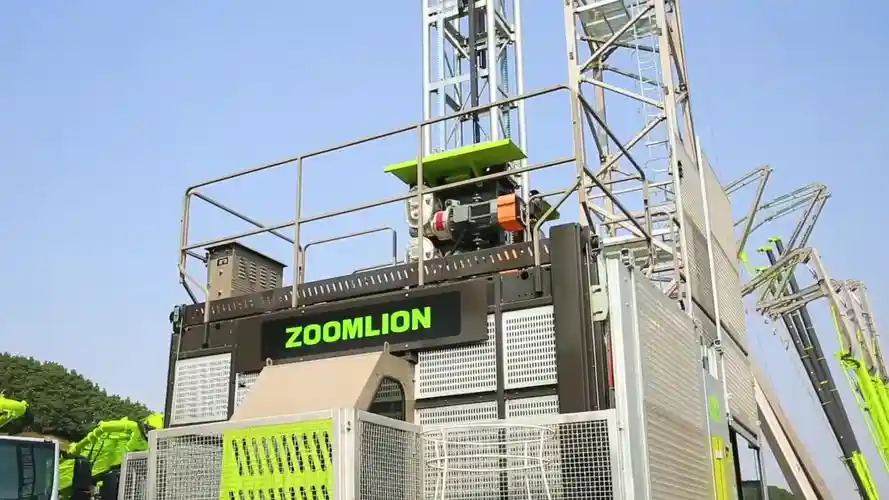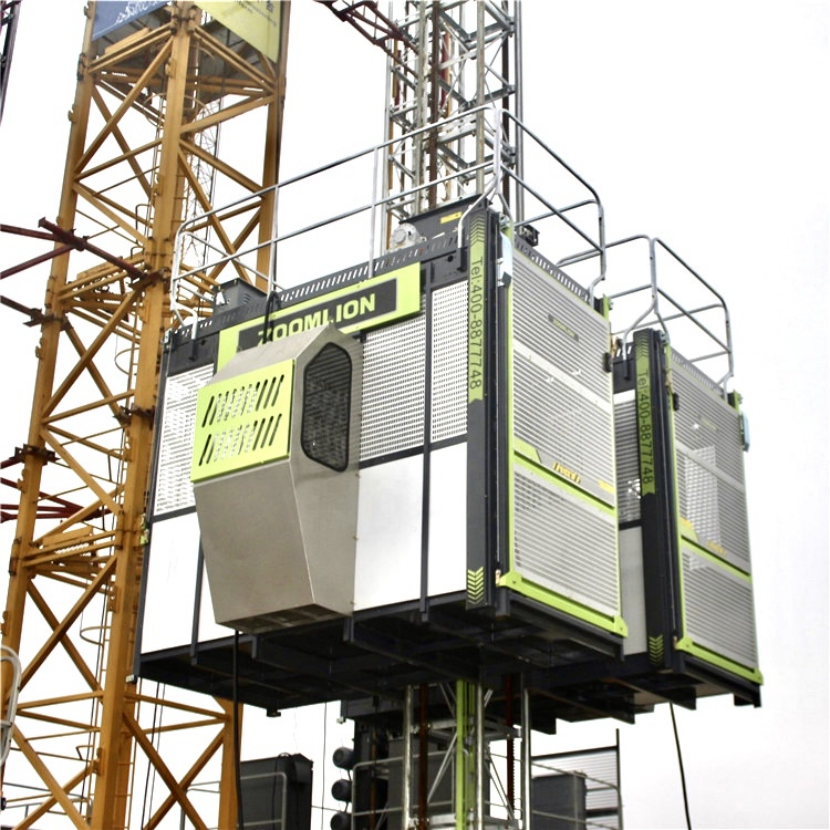The Role of Construction Hoists in Modern Building
Industry News
2025/01/14
Construction hoists play a role in contemporary construction endeavors as they serve as the primary means of vertical transportation at building sites. They are commonly referred to as personnel hoists or construction hoists and aid in transporting materials and workers between floors of a structure. These devices are instrumental in ensuring that projects are carried out securely and with efficiency.
Understanding the Basic Function of Construction Hoists
Construction hoists are customized tools created to raise loads vertically by surpassing the restrictions of human power and the force of gravity. They allow you to transfer materials and workers to heights at a construction location necessary for finishing a project. These machines make use of a drum or wheel attached to a rope or chain to lift objects that would be impossible for humans alone.
Key Components of Hoists
To use construction hoists safely and efficiently requires understanding the components that enable their operation smoothly at the job site. Some essential parts include:
-Mast:Also known as the guide rail bracket, the mast is the main vertical support made of steel sections that bolt together to form a tower.
-Cage:The cage is an enclosed platform that travels up and down the mast to transport workers, equipment, and construction materials.
-The upper part connects to the lifting system via a steel frame.
-The lower part has a sturdy floor that holds the load.
-Underframe:This component supports the entire hoist structure and distributes the load to the foundation.
-Protection Fence:This part adds a level of safety.
-Wall Ties:These secure the mast to the building to enhance stability.
-Cable Guide Rail:This protects and manages cabling to prevent tangling.
-Drive System:Located atop the cage, this system includes a driving board and frame with multiple units.
-Electrical Components:These may include a variable frequency speed control and various switches and controls for operation.
Safety and Operational Aspects of Hoists
When using a construction hoist ensure safety measures are followed meticulously in terms of upkeep and operation while managing loads properly to reduce accidents.
Essential Safety Protocols for Hoist Operation
When using a construction elevator or lift on a job site or project site for transporting workers and materials to different levels within the building or structure under construction or repair work in progress following safety guidelines is crucial, for the well-being and security of everyone involved in the operation.
-Carefully read the hoist’s operational manual.
-Ensuring all safety devicesare enabled and working properly.
-Using correct signaling methodsduring operation.
-Understanding the hoist’s load capacities.
-Adhering to lifting speedguidelines to prevent instability or load swing.
Importance of Regular Inspection and Maintenance
Regularly checking your hoists is essential to guarantee their safety and durability over time aligning with the advice provided by the American Society of Mechanical Engineers (ASME) or following the maintenance instructions from the manufacturer is vital for conducting inspections as part of your routine upkeep:
-Daily Inspections: You should check for any visible damage or wear before each use.
-Periodic Maintenance: You should replace worn parts and keep detailed maintenance records.
Installation, Setup, and Types of Hoists
Ensuring your construction lift is properly installed is crucial for its effective functioning requiring thorough site preparation and precise assembly of its components.
Critical Steps for Hoist Installation and Setup
Before setting up a hoist on site, it’s crucial to ensure that the construction area is well prepared. This preparation involves:
-Assessing the Ground:You must make sure the foundation is solid and level, perform soil analysis, and use stabilizers if needed.
-Clearing Debris:You should remove any obstacles that might interfere with the hoist.
-Establishing Safety Zones:Mark off areas to keep unauthorized personnel away during the installation process.
-Utility Checks: You need to verify the location of any underground utilities to prevent damage during drilling for anchor points. After preparing the site, follow these steps for hoist assembly:
-Unloading and Inspection: Carefully unload and inspect all components for damage before assembly.
-Assembling Mast Sections: Connect the mast sections using the provided bolts and fasteners, adhering to the manufacturer’s guidelines, and use a crane if needed.
-Attaching the Hoist Cage: Securely attach the platform or hoist cage to the frame, making sure all safety systems are correctly in place.
-Installing Electrical and Mechanical Systems: You need to install the electrical and mechanical components, including brakes, motors, and control panels, with a professional’s help.
-Testing: Perform thorough tests on the hoist, checking movement, emergency stops, and overload systems.
Distinguishing Between Material and Personnel Hoists
In construction and industrial environments, you can come across two categories of hoists. Material hoists and personnel hoists each serve distinct lifting requirements:
-Material Hoists: These are used for transporting materials like tools, equipment, and construction supplies. When selecting a material hoist, you must consider:
-Load Capacity:Ranging from light-duty to heavy-duty.
-Lifting Speed:Varies according to model and job requirements.
-Platform Size:Must be sufficient to hold the materials you need to lift.
-Personnel Hoists: These are designed to safely lift workers to various heights on a job site. Personnel hoists must include:
-Safety Features:Such as emergency brakes, interlocks, and overload alerts.
-Compliance:Personnel hoists must meet or exceed industry standards.
Applications of Hoists in Different Environments
Construction hoists are flexible and can be adjusted to suit project needs, so it’s important to think about the unique demands of each setting when selecting a lift.
Hoists in High-Rise Projects
To build buildings effectively and securely, you’ll require hoists that can move up and down long distances smoothly and safely. These hoists should be able to carry loads and have controls for speed adjustment to keep the work going at a consistent pace. The elevator needs to integrate seamlessly into the construction workflow so that operations can proceed without interruptions.
Hoists in Industrial and Manufacturing Settings
In manufacturing settings, hoists commonly take the shape of industrial hoists. The prime concern here is ensuring durability and dependability given the use and challenging environments these hoists face. Key attributes encompass strength, accurate controls, intricate operations, and the capability to lift hefty industrial parts securely.
Auxiliary Equipment and Operational Considerations
In addition, to the hoist itself, you must have a grasp of the supporting equipment required to operate it effectively.
Control Stations and Remote Operation for Hoists
You can use control stations to control a hoist, which comes in two types.
-Wired Pendant Station:This type of station connects to the hoist with a wire link, providing precise control from a specific location.
-Wireless Controls:These offer enhanced mobility and safety, allowing you to control the hoist from a safer distance.
Make sure to choose the additional gear that suits the kind of lift and meets the needs of your particular work location.
The Significance of Hoists in Construction
Construction hoists play a role in ensuring the safe and effective movement of materials and workers at construction sites; their proper installation and upkeep necessitate specific skills and knowledge.
MachPlaza: Your Reliable Partner for Construction Hoists
MachPlaza stands out as a provider of Chinese construction machinery globally with a diverse range of offerings such as full machinery exports and spare parts supply services along with accessories to meet various needs. Their dedicated team prioritizes customer satisfaction through pricing and on-time deliveries while aiming to establish lasting relationships with companies worldwide. MachPlaza goes the mile by providing valuable services from the initial purchase phase to post-sales support to ensure a seamless experience for their customers.
The XCMG SC200JS1 and ZOOMLION SC200/200EB(BWM-4S) are both construction hoist models suitable for high-rise projects, and are available from MachPlaza.
Both models have a rated load capacity of 2×2000 kg. The XCMG model has a lifting speed of 0-50 m/min, while the ZOOMLION has a lifting speed of 0-40 m/min. The XCMG model features a durable steel structure with advanced safety systems and a comfortable, spacious cage. The ZOOMLION model has anti-fall and anti-rolling control, a high-efficiency reducer and features face recognition authentication. Both are suitable for moving personnel and materials efficiently and safely.
Conclusion
Hoists play a role in various industries such as construction and manufacturing as well as in every day activities by enabling tasks that would be challenging to accomplish solely relying upon human physical strength alone. Choosing the hoist for a particular task is vital to ensure both efficiency and safety are upheld.



